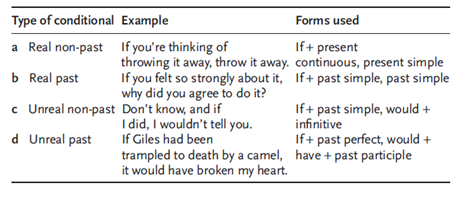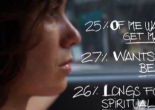Introduction
This post is about IF sentences or Conditionals. This is also Week 10 of the syllabus that was chosen by the learners. In this post I will share a lesson that I did which focuses on consciousness-raising – making the learners aware of conditional forms as they are used in real life.
For busy teachers the lesson plan with all handouts is available from Google docs here.
Background
I recently completed the Training the Trainer course at Oxford Tefl Prague. While observing one of the teachers there, the issue of ‘pedagogical truth’ came up: how there is a gap between what we teach and how the language is actually spoken.
But it doesn’t have to be like this. I believe that one of the enabling conditions for Decentralised Teaching is that the distance between academic knowledge and practitioners is narrowing. Teachers are increasingly able to use concepts, ideas and theories directly from SLA research in their teaching and can feedback these results through action research or more informally through blogs. We can see increasing interaction between the two in projects such as the ELT Research Blog carnival.
Moreover, with the rise of corpus-based research we should be able to give learners more accurate information on how English is really spoken. The conservatism of the ELT publishing industry, and the time it takes to incorporate new developments in ELT into existing coursebooks may mean that learners are missing out on opportunities to pick up more sophisticated, authentic and useful grammar structures and vocabulary, though I accept that corpus research has started to influence new ELT materials.
The fact is that language (even by competent non-natives) is just much more varied in real life than how it is presented in coursebooks.
Let’s take an example:
If you haven’t been to Venice – you haven’t lived!
Which conditional is that? Answers on a postcard please…
What’s so interesting about conditionals?
Conditionals are sometimes difficult for learners, as different languages have different ways of expressing contingency. But even when learners grasp the forms and meaning of conditional sentences they lack the ability to create more sophisticated conditional structures with confidence. This has a lot to do with the way that conditionals are presented, as zero, 1, 2 and 3 which are often perceived as ‘fixed’ categories.
Maule (1988) wrote that a more accurate division of conditionals than the ‘standard’ zero, 1, 2 and 3 is to divide them into Real past/ non-past and Unreal past/ non-past. Below is a table showing examples (taken from Jones and Waller 2010, adapted from Maule 1988:122).

Maule’s sample was taken from a random selection of television programmes, while Jones and Waller used a random sample of 250 concordance lines from the British National Corpus (2009). Jones and Waller found that in 192 examples taken from the Corpus (of 250, some were omitted for not using If, or being fragmented ), 131 fit into Maule’s category A. This means that approximately two thirds of conditional use in the study was Real Non-past. Also, they found that this category comprised of 24 different patterns! It’s also worth noting that the third conditional came up only 6 times.
What are the pedagogical implications of this?
Anyone seen a third conditional recently?
As Michael Lewis says (referred to by Maule), by artificially simplifying language we are only storing up trouble for later. For example, why are we teaching the first conditional when, in its classic form, it’s actually quite rare. Likewise, the Third Conditional is the grammatical equivalent of a dodo! This would seem to chime with my own and other teacher’s experience when teaching conditionals, which amounts to – would anyone actually say that? E.g. If the sun shines I will be happy.
It’s also true that learners have no idea of the comparative frequency and usefulness of the different conditionals. Dividing them into ‘neat’ compartments, while providing a good rule of thumb, risks blinding them to the more messy but genuine uses of conditionals in real life and may restrict their learners ability to communicate effectively in certain situations. Making learners more aware of the different variations of conditionals can, I think, help them to speak with more variety and confidence.
Rationale
So to summarise, the three reasons I chose to teach conditionals this way are:
- the conventional way of presenting conditionals does not match reality
-
we are storing up trouble for learners if we don’t equip them to deal with this linguistic reality (even communicating with competent non-natives)
-
‘knowledge is power’ – learners need to know how frequent and common certain conditionals are – all conditional sentences are not equal
What are the risks here? Of course, if learners are already struggling to learn the ‘standard’ conditional forms any more complexity runs the risk of overloading the students. But maybe the ‘standard’ forms are not fit for purpose anymore?
Lesson context
The lesson is designed to be an inductive, ‘consciousness-raising’ materials-light lesson to promote a wider awareness of conditional use and is designed to be used at B2+ level. Moreover, the lesson has a real-life situation as its core; so many lessons on conditionals are divorced from real-life decisions and situations. Which doesn’t make sense when teaching a form that deals with contingency! Finally, the lesson is designed to be engaging and fun for the learners.
The Lesson
There are 7 stages in the lesson and it’s divided into two parts, Pre-Text (the text here is a film) and Post-Text. Of course, you’re free to modify anything as you see fit – the full lesson with handouts is available here.
Pre-Text
1) The teacher goes over conventional zero, 1, 2 and 3rd conditional forms with learners using the WB.
2) Teacher gives five sentences to learners and asks them to compare them with these traditional conditional forms. This is to start them thinking beyond zero, 1, 2 and 3 conditionals. Some of these sentences are adapted from Jones & Waller (2010), where you will find plenty of examples of non-traditional conditionals.
1. If we’re going to eat out tonight, then let’s go to that new Italian!
2. If they’re closed, I can wait til tomorrow.
3. If you wanted to know the answer, you had to keep pressing the ‘show’ button.
4. If anything could send strange signals, the Thing could.
5. If I had known that I would have done it.
(Only sentence 5 fits with a conventional structure – 3rd conditional)
3) Warm-up for film text. Have a brief open-class discussion on the following question:
‘What’s the Best Age to get Married?’
4) Watch the film ‘35 and single‘ (at top of page)
Post-text
5) In Groups – Write sentences using IF on slips of paper. They need to write sentences from the following points of view:
i) Paula’s point of view
ii) Her parents point of view
iii) Her friend’s point of view
iv) Her boyfriend’s point of view
6) Learners then put their sentences into four groups:
a) Real non-past e.g. If you don’t get married now, you never will
b) Real past e.g. If you watched the film, you saw how many of my friends got married and had children.
c) Unreal non-past e.g. I would tell her to get married if she was my daughter.
d) Unreal past e.g. If her parents hadn’t divorced, perhaps she would have got married sooner.
*Optional stage at 6.5 – see below
Bear in mind the following guidelines for the conditions in IF sentences (taken from Jones & Waller 2010):
Real – Something which actually happens, or which happened, or will happen
Unreal – Something which did not actually happen, does not happen, or is not likely to happen
Non-past – This can be present, future, general or unspecified time
7) Wrap up/ plenary – This is a guided discussion on the following questions:
1) Which category a, b, c or d has the most conditional sentences? For teacher: hopefully category A Real non-past is the answer here – if not teacher states that category A is the most common in native speaker talk according to research
2) How many different forms did you have in the category a sentences? How many different forms did you have in the category d sentences? What does this tell us? Example answer: that there is a lot more variation in category A
3) What implications does this have for learning IF sentences/ conditionals? Example answer: that we should focus more on category A forms and their variants
Conclusions
There was a very good response to this lesson. The learners found it difficult to grasp the distinction between the four categories (as I did at first!) but it became easier as the lesson progressed. The video was engaging and they were coming up with a lot of interesting sentences which varied from the normal forms given in coursebooks.
Hope that you found this lesson useful – there is a Google doc with all the handouts in teacher-friendly formats here – drop me a line if you use this material in class!
paul
REFERENCES
Jones, C. & Waller, D. (2010). ‘If only it were true: the problem with the four conditionals’. ELT Journal. OUP.
Maule, D. (1988). “’Sorry, but if he comes, I go’: teaching conditionals”. ELT Journal Volume 42/2, April 1988. OUP.
*6.5 Optional stage – Learners then give their sentences to another group. The next group has two tasks:
– If they think there is a mistake in the conditional sentence – they should underline it
– They should discuss and write on the slip WHO they think is saying this sentence (Paula, her parents, etc.)


hi
this is a great corpus based lesson , thanks
going to share it on the G+ corpus linguistics community do consider joining it 🙂
another interesting result from corpus work is the 3 most common modals used in the if part – be to, can, could –
http://eprints.lancs.ac.uk/140/1/Conditional_Sentences_-_ELT_typology_and_corpus_evidence.pdf
ta
mura
Hi Mura,
Thanks for commenting – the pdf link you posted is very interesting, particularly on the ‘be to’ in IF sentences, I’d never thought of that. Share away on G+, the more the merrier! 🙂
Cheers,
paul
This is not spam. Just testing what happens when I post a comment on here. Phil.
Many thanks – a great-looking lesson and a subject close to my heart. As a trainer on the Cert TESOL (incidentally at OH BCN) I have to run the trainees through the traditional conditional categories – mainly to prep them for their exam, as I don’t feel it really helps their teaching, and gets them into a mindset of avoiding any language that doesn’t fit. So I came up with an extension activity which starts, just like yours, with getting them to look at real examples of if-structures and attempt to fit them into the categories they’d studied. I was trying to throw a spanner in the works in a hopefully productive way but I probably overloaded them – I’ll scale it down for next time. Anyway, here it is for anyone to use or adapt as they wish: https://www.dropbox.com/s/x9jdev7610alw1n/Non-standard%20conditionals.docx
Your ideas are a lot more developed so thanks again and I’ll be giving this a try!
Hi Neil,
Many thanks for your kind comments! I’m so glad that someone else feels the same way as I do about teaching conditionals. I had a student at B2/C1 the other day and I spent the whole lesson ‘unteaching’ the 0,1,2 and 3 fixed categories and explaining that there’s a lot more variety out there in the real world (‘jungle english’). I have no problem in theory with teaching rules of thumb, but when the gap between what is taught and what is spoken becomes a chasm, then I think we should change the way we teach. BTW, your lesson is really interesting and I’ll try it in class- thanks for sharing. I think at the very least your learners will have a broader, more holistic view of conditionals than I did when I finished my CELTA!
Wow : )
As an ESL / Business English teacher currently teaching my students conditionals, I’m really grateful for this post, cos as you point out there’s soooooo many exceptions to the 0, 1, 2, 3 model.
I am going to try and incorporate your approach into my teaching.
I’m currently teaching my students the use of may/ might/ could in the “consequence clause” as a way of lowering the probability of *that* part of a conditional sentence.
And teaching them the use of the imperative for “Category 1” conditional sentences, for demands/ advice / requests.
e.g. If the motor overheats, turn it off immediately.
Also, I’m trying to teach them the use of could and would as a polite form of making requests.
Currently, I’m struggling to get my head *quite* around the following sentence structure:
We would be very grateful if you could send us your catalogue.
and/ or
If you could send us your catalogue, we would be very grateful.
According to the “traditional” 0,1, 2, 3 model, is this a “Category 1” sentence? With a modal “could” added for politeness?
Or do I need to explain this sentence structure to my students differently? *confused* : )
I find it’s quite an important structure for Business English, as it’s used so often.
Many thanks for any of your thoughts!
And a big hi from a fellow teacher also in Germany (and who’s also gotten into (and then moved beyond) a rut in Germany, haha, I think that’s quite easy to do)
Cheerio
Sophie
Hi Sophie,
Thanks for you comments, sorry for delay in replying.
Regarding: “We would be very grateful if you could send us your catalogue.” I’m not sure this is a conditional, because there’s no ‘condition’ to be fulfilled i.e. What is the result if I DON’T send my catalogue. I would teach it as a fixed phrase.
Compare with: “If you don’t send us your catalogue, we won’t be able to buy any of your products.” That has a clear condition, and result.
Hope that helps – I was stumped myself for a while. Good luck with trying out my approach. Let me know how it goes with your learners.
best,
paul
P.S. Do you write blog posts about Pedagogy for the 21st Century, specifically?
I’m finding myself surrounded by very old-school teachers (if you’ll pardon the pun) and am finding the pedagogy soooo antiquated and would love some pointers to intelligent, succint posts/ websites/ sources specifically about less stuffy approaches to pedagogy (ideally without getting bogged down in too much dogma or ad nauseum debate tho)
; )